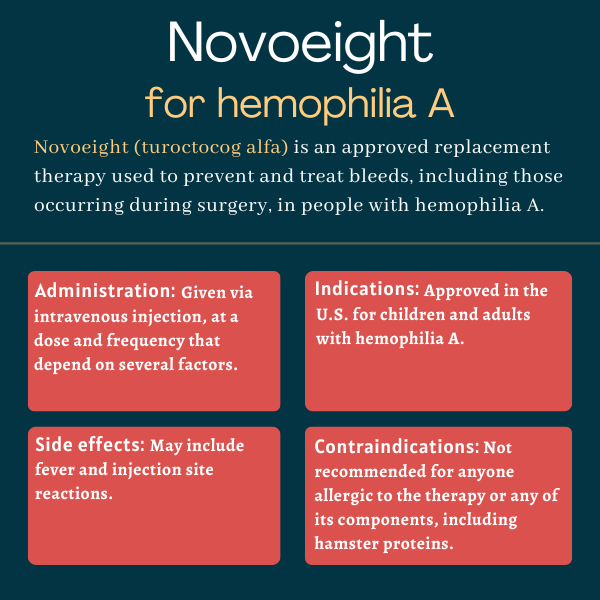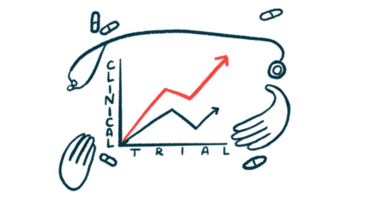Novoeight (turoctocog alfa) for hemophilia
Last updated Aug. 2, 2024, by Marisa Wexler, MS

What is Novoeight for hemophilia?
Novoeight (turoctocog alfa) is a recombinant, or man-made, clotting factor replacement therapy approved to prevent and treat bleeds, including those occurring during surgery, in people with hemophilia A.
The therapy, administered via an intravenous (into-the-vein) injection, is marketed by Novo Nordisk.
Therapy snapshot
| Brand name: | Novoeight |
| Chemical name: | Turoctocog alfa |
| Usage: | Prevention and treatment of bleeding episodes, including those occurring during surgery, in hemophilia A patients |
| Administration: | Intravenous injection |
How does Novoeight work?
Hemophilia A is caused by a deficiency in factor VIII (FVIII), a protein that’s required for blood clotting, due to the presence of genetic mutations that impair the protein’s production or function. This deficiency in FVIII puts patients at an increased risk of experiencing excessive and prolonged bleeding.
Novoeight contains a recombinant, or lab-made, version of the FVIII protein that’s produced using a genetically engineered Chinese hamster ovary cell line. It is used as a replacement therapy to supply a working version of FVIII and promote blood clotting in people with hemophilia A.
Who can take Novoeight?
Novoeight was approved by the U.S. Food and Drug Administration in October 2013. It is indicated for use in adults and children with hemophilia A as:
- an on-demand treatment to control bleeds
- a perioperative treatment to manage bleeding during surgery
- a prophylactic (preventive) treatment to reduce the frequency of bleeding episodes.
Novoeight is similarly approved in the European Union and other regions to treat and prevent bleeds in people with hemophilia A.
Who should not take Novoeight?
Novoeight is contraindicated, or not recommended, to anyone who has had a life-threatening allergic reaction, including anaphylaxis, to the therapy or any of its components, including hamster proteins.
The therapy is also not indicated for von Willebrand disease, a bleeding disorder distinct from hemophilia.
How is Novoeight administered?
Novoeight is given by an intravenous injection. Patients should not self-administer the therapy unless they’ve been taught how to do so safely by a healthcare provider or hemophilia treatment center.
The medication is available as a white powder in single-use vials that contain 250, 500, 1,000, 1,500, 2,000, or 3,000 international units (IUs) of FVIII. Before injection, the powder must be reconstituted, or diluted, in 4 mL of a saline solution, which is provided along with the therapy.
Novoeight should be injected slowly over the course of two to five minutes. The therapy should be administered immediately after being reconstituted or within a maximum of four hours thereafter if stored at a temperature below 86 F (30 C).
The dosage and duration of Novoeight treatment depend on the severity of FVIII deficiency, the location and extent of bleeding, and the patient’s clinical condition and response to therapy.
When used on-demand to control bleeds, Novoeight should be given:
- every 12 to 24 hours to maintain FVIII activity levels at 20%-40% of normal for at least one day until bleeding is resolved in the case of minor bleeds (e.g. minor muscle or oral bleeds)
- every 12 to 24 hours to maintain FVIII activity levels at 30%-60% of normal for about three to four days until pain and acute disability are resolved in the case of moderate bleeds (e.g. muscle bleeds, mild head trauma)
- every eight to 24 hours to maintain FVIII activity levels at 60%-100% of normal for about seven to 10 days until bleeding is resolved in the case of major bleeds (e.g. fractures, bleeding in the brain or gastrointestinal tract).
When used in surgery, the recommended dosing schedule of Novoeight depends on the extent of the operation.
For minor surgeries, including tooth extraction, Novoeight should be given every 24 hours to maintain FVIII activity levels at 30%-60% of normal for at least one day until healing is achieved.
For major surgeries, such as joint replacement surgery or those involving the brain, the therapy should be given every eight to 24 hours to maintain FVIII activity levels at 80%-100% of normal until wound healing is complete, then continued for at least seven days to maintain FVIII activity at 30%-60% of normal.
When used for routine prophylaxis in patients 12 and older, Novoeight should be given at a dose of 20-40 IU per kilogram of body weight (IU/kg) every other day, or at a dose of 20-50 IU/kg three times weekly. In children younger than 12, the medication should be given at a dose of 25-50 IU/kg every other day, or at a dose of 25-60 IU/kg three times weekly.

Novoeight in clinical trials
The safety and efficacy of Novoeight as an on-demand, prophylactic, and perioperative treatment for patients with hemophilia A was evaluated across four Phase 3 clinical trials, all belonging to the guardian clinical trial program. The trials enrolled patients who had severe hemophilia A and no history of FVIII inhibitors, which are neutralizing antibodies targeting the delivered FVIII that can lower the therapy’s efficacy.
Three of these studies — guardian 1 (NCT00840086), guardian 2 (NCT00984126), and guardian 3 (NCT01138501) — included patients who had previously received other hemophilia A replacement therapies. Guardian 2 was an extension study open to patients who completed guardian 1, guardian 3, and Phase 1 studies that assessed Novoeight’s pharmacokinetic properties (its movement into, through, and out of the body).
The fourth trial, called guardian 4 (NCT01493778), included 59 children younger than 6 who had never previously received a hemophilia replacement therapy.
On-demand treatment
Across these trials, Novoeight was used on-demand to manage 3,153 bleeds in 260 patients. Slightly more than half of the treated bleeds were spontaneous, and most (90%) were rated as being mild or moderate in severity.
The efficacy of on-demand Novoeight was rated as “good” or “excellent” in 89% of all treated bleeds. Overall, nearly 9 in 10 (89%) bleeds were resolved with one or two injections of Novoeight. These observations were generally comparable in patients regardless of whether or not they had previously been on other FVIII replacement therapies.
Prophylaxis
Two of the trials — guardian 1 and guardian 3 — evaluated Novoeight as a routine prophylactic treatment in previously treated patients. Guardian 1 enrolled 150 adults and adolescents, 12 and older, who were treated for six months, while guardian 3 enrolled 63 children younger than 12 who were treated for four months. In these patients, Novoeight was given every other day or three times weekly.
The median annualized bleeding rate for adults and adolescents participating in guardian 1 was 3.7 bleeds per year, while children younger than 12 in guardian 3 had a rate of 3 bleeds per year. The overall median annualized bleeding rate for both trials was 3.7 bleeds per year. Across all age groups, the rate was about three to four bleeds per year.
Most of the patients who completed the original trials opted to enroll in the guardian 2 extension study to continue receiving Novoeight prophylactically for up to six years. Data from the extension study showed the median annualized bleeding rate was 1.4 bleeds per year. Across all age groups, the rate in guardian 2 was about one to two bleeds per year.
In previously untreated children younger than 6 who received prophylactic Novoeight in guardian 4, the median annualized bleeding rate was 2.9 bleeds per year.
Use in surgery
Across the three trials involving previously treated patients, Novoeight was used to manage bleeding during major or minor surgeries in more than 20 patients. In all surgeries, clinicians rated the efficacy of Novoeight to control bleeding as “good” or “excellent.”
Common side effects of Novoeight
The most common side effects of Novoeight are fever and injection site reactions, and the development of inhibitors in previously untreated patients.
Allergic reactions
Allergic reactions, including severe reactions known as anaphylaxis, are possible with Novoeight. Because the medication contains small amounts of hamster proteins, it’s possible patients can develop allergic reactions to the proteins.
Early signs of an allergic reaction may include swelling, chest tightness, shortness of breath or wheezing, hives, and itching. If an allergic reaction to Novoeight occurs, appropriate treatment to manage the reaction should be given immediately, and Novoeight treatment should be stopped.
Development of inhibitors
Sometimes the immune system may mistake clotting factors in replacement therapies as an infectious threat. When this happens, immune cells produce antibodies against those proteins. These antibodies are called inhibitors because they can prevent the therapy from working properly. The risk of developing inhibitors is particularly high in previously untreated patients.
Patients on Novoeight should be regularly tested for the presence of inhibitors, especially if they aren’t responding to treatment as well as expected. Levels of FVIII activity should also be monitored to ensure that adequate levels of this clotting protein can be maintained.
Use in pregnancy and breastfeeding
Novoeight has not been adequately studied in women who are pregnant or breastfeeding, and animal studies during pregnancy or lactation have not been conducted. Therefore, it’s not known if the therapy can be harmful to a developing fetus, pass to breast milk, or have a negative effect on breastfed infants.
The therapy should be used in these situations only if the potential benefits of treatment clearly outweigh the possible risks.
Hemophilia News Today is strictly a news and information website about the disease. It does not provide medical advice, diagnosis, or treatment. This content is not intended to be a substitute for professional medical advice, diagnosis, or treatment. Always seek the advice of your physician or other qualified health provider with any questions you may have regarding a medical condition. Never disregard professional medical advice or delay in seeking it because of something you have read on this website.
Recent Posts
- Why someone else’s weight struggles are a private matter
- New gene therapy reduces bleeding rates for hemophilia B patients
- Hympavzi boosts quality of life for hemophilia patients in trial
- When women with bleeding disorders show up for each other
- In our family, we each play a role in navigating hemophilia
Related articles




